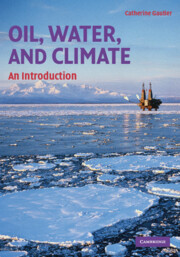Book contents
- Frontmatter
- Contents
- Foreword
- Introduction
- 1 Overview
- 2 Carbon Dioxide Emissions, Global Warming, and Water Resources
- 3 Population, Environmental Impacts, and Climate Change
- 4 Carbon Cycle and the Human Impact
- 5 Peak Oil, Energy, Water, and Climate
- 6 Oil Consumption and CO2 Emissions from Transportation
- 7 Oil, Economy, Power, and Conflicts
- 8 Energy Alternatives and Their Connection to Water and Climate
- 9 The Water Cycle and Global Warming
- 10 Fresh Water Availability, Sanitation Deficit, and Water Usage: Connection to Energy and Global Warming
- 11 Rivers, Lakes, Aquifers, and Dams: Relation to Energy and Climate
- 12 Water Contamination, Energy, and Climate
- 13 Geopolitics of Water and the International Situation
- 14 Water Alternatives
- 15 Global Climate Change: Observations, Modeling, and Predictions
- 16 Energy and Water Challenges and Solutions in a Changing Climate Framework: Commonality, Differences, and Connections
- References
- Index
16 - Energy and Water Challenges and Solutions in a Changing Climate Framework: Commonality, Differences, and Connections
Published online by Cambridge University Press: 05 September 2012
- Frontmatter
- Contents
- Foreword
- Introduction
- 1 Overview
- 2 Carbon Dioxide Emissions, Global Warming, and Water Resources
- 3 Population, Environmental Impacts, and Climate Change
- 4 Carbon Cycle and the Human Impact
- 5 Peak Oil, Energy, Water, and Climate
- 6 Oil Consumption and CO2 Emissions from Transportation
- 7 Oil, Economy, Power, and Conflicts
- 8 Energy Alternatives and Their Connection to Water and Climate
- 9 The Water Cycle and Global Warming
- 10 Fresh Water Availability, Sanitation Deficit, and Water Usage: Connection to Energy and Global Warming
- 11 Rivers, Lakes, Aquifers, and Dams: Relation to Energy and Climate
- 12 Water Contamination, Energy, and Climate
- 13 Geopolitics of Water and the International Situation
- 14 Water Alternatives
- 15 Global Climate Change: Observations, Modeling, and Predictions
- 16 Energy and Water Challenges and Solutions in a Changing Climate Framework: Commonality, Differences, and Connections
- References
- Index
Summary
Many water and energy challenges have been identified in the previous chapters and their origin diagnosed. Addressing them in a changing climate will require innovative solutions on a global scale.
To avoid painful consequences in the future, tackling the energy and climate security challenge and eliminating the crisis in water and sanitation will likely require a break with business as usual. The time frame for action on all these fronts is clearly within the next few decades. New solutions will be needed in electricity production, transportation, and water management, at a minimum. Technology might come to the rescue, but increased efficiency and conservation must play a large role. And adaptation to climate changes will be unavoidable. Global, national, and regional leadership will be needed to achieve energy, water, and climate security and to invent new paradigms for global resource management. Education must figure prominently as a component of every proposed solution.
Addressing these challenges properly and quickly can be seen as a test of humanity that is rendered even more difficult by projected changes in climate.
Introduction
In the context of global warming, population increase, and economic growth, energy, water, and climate need to be considered as interconnected and synergistic factors. It is not a responsible approach to address energy security without simultaneously assessing the consequences of each energy choice on climate and water resources and without accounting for them in the development of energy plans.
- Type
- Chapter
- Information
- Oil, Water, and ClimateAn Introduction, pp. 310 - 336Publisher: Cambridge University PressPrint publication year: 2008



